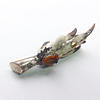
Peter, whilst I am not saying that the uninitiated should attempt to do so, for 30+ years from the 50s through to the 90s my father assembled hundreds of gross of the tubes for the above for Ward Bros of Birmingham from gilding metal and silver stampings (at a ratio of about 90/10). This involved, in part, soldering various forms of the domed cap to the end of the tube, the edges of which he then ground flush with the tube body on a bench grinder. As far as I can remember he used a Carborundum grinding wheel which he frequently dressed with a revolving wheel steel dressing tool. So presumably bench grinders can be used with soft metals with specific wheel types and precautions?
I must admit, I hated that bench grinder, and stayed well away from it! Not always easy when my fathers workshop was at one end of the kitchen.



 Reply With Quote
Reply With Quote

 what about sanding on a bench sander?
what about sanding on a bench sander?


Bookmarks